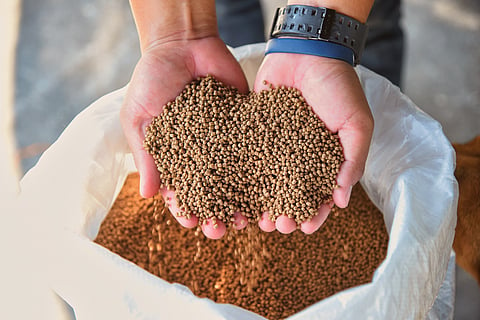

Aquaculture feed.
Photo: Adobe Stock
A new study on the sustainability of aquafeed ingredients calls for the aquaculture industry to integrate circular economy principles into how fish feeds are designed and produced.
The study, "Toward Applying a Circularity Framework Against the Use of Aquaculture Feed Ingredients", published in the peer-reviewed journal Reviews in Fisheries Science & Aquaculture, explains how ingredient choices can be guided by circular thinking to reduce environmental impacts while maintaining consistent nutrition and supply. The lead author of the paper was Dr Brett Glencross, Technical Director at IFFO.
The research builds on the circularity framework developed by the European Feed Manufacturers’ Federation (FEFAC), which is based on four pillars: reducing the use of food-grade resources for feed, cutting reliance on land, sourcing ingredients locally, and optimising nutritional value.
“One of the key drivers of circularity is the need to improve sustainability of feed ingredient use,” Glencross said, via a press release. “By applying a common, agreed set of rules, we can ensure that environmental burdens are not simply transferred from one product to another.”
The study found that marine ingredients such as fishmeal and fish oil can have a lower carbon footprint than many plant-based alternatives, warning that reducing their use without a holistic view could actually increase the overall footprint of aquafeeds.
Modern aquafeeds now use more than 40 ingredients, the authors point out, noting that over the past two decades, the average share of marine ingredients has fallen from 25% to 9%, as plant-based raw materials have become more common.
While this change has eased pressure on wild fish stocks, it has also connected aquafeed production more closely to agriculture, which brings new challenges, including biodiversity loss and higher carbon emissions, the authors state.
The study also highlights that more than 40% of raw materials for marine ingredients now come from fish by-products, sourced from both wild-caught and farmed fish processing. As aquaculture expands, the volume of these by-products – and their potential use in feed – is expected to grow.
However, the authors stress, new circular feed ingredients must meet strict standards before they are used at scale. This includes being digestible and bioavailable, with a reliable nutrient composition and consistent annual production of at least 10,000 tonnes to be commercially viable.
“There is no point in producing a circular feed ingredient if its nutritional characteristics undermine the capacity to formulate a nutritious and balanced feed,” the paper states.
The researchers also highlight opportunities to make use of compounds from waste streams, such as fish silage and peptides, which may boost fish growth and feed performance.
The study concludes that achieving true circularity will require coordinated action between ingredient producers, feed manufacturers, fish farmers, researchers and regulators.
